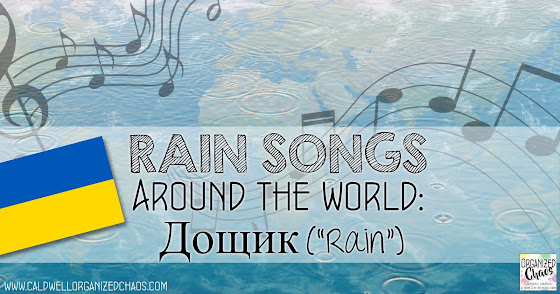The title of this Ukrainian song is Дощик, which translates to "Rain". Fits right in with the rain theme! Actually I found a couple of fairly widespread Ukrainian rain songs, and both of them use the same onomatopoeia word for the sound of the rain that is quite fun to sing. In the verses of this song you'll hear the word of every line:
I love using songs in different languages that have a repeated word or phrase that is quick and easy for students to learn without knowing the language, so this song definitely fits the bill. After we listen to it one time, I ask students to tell me what the Ukrainian word is for the sound of raindrops and they can immediately identify the sound! Then I play the recording again and have students sing along with just that word. Here are the lyrics for the first verse:
Дощик ллється цілий ранок - кап-кап-кап! It's been raining all morning, kap-kap-kap!
Не виходимо на ґанок - кап-кап-кап. Let's not go out on the porch, kap-kap-kap!
Раптом бачим під кущем Suddenly we see under the bush,
кап-кап-кап-кап-кап! kap-kap-kap-kap-kap!
Мокне зайчик під дощем The bunny gets wet in the rain,
кап-кап-кап-кап-кап! kap-kap-kap-kap-kap!
Once we've sung through the song, singing just the rain sounds, I ask students to identify the 2 different sections in the music. It's easy for them to notice that there is one part that has the "kap" sound in it and another section that doesn't. This is an easy way to review form/ same and contrasting sections, and identify the ABABA form.
For younger students I stop there, and we compare and contrast this song with other songs about rain. For older students this is a great song to introduce or review major and minor tonalities! After identifying the form, I ask them what makes the 2 sections sound different from each other. The B section (chorus) lyrics are:
Ой ти, зайчику сіренький, ой ти, зайчику маленький! Oh you gray bunny, oh you little bunny!
годі мерзнути, дрижати, ти ходи мершій до хати, You're freezing and shivering, go home!
ми дамо тобі морквину ще й велику капустину, We will give you carrots and cabbage.
понесеш їх у лісок годувати діточок, Take them to the forest to feed your children
бо маленькі зайченята вже давно чекають тата. The babies have been waiting for their dad.
There is a clear switch from minor to major between the A and B sections, and it's interesting to discuss with students why the composer may have chosen to put the verses in minor and the chorus in major (maybe because the bunny is getting some food to take home to his family?).
After comparing and contrasting "Rain, Rain, Go Away" with the Japanese "Amefuri" and talking about the differences in attitude towards the rain in the two songs, this is a great follow-up song because of the switching back and forth between tonalities. This could be a great jumping off point for a composition activity with older students, when they're learning to write melodies in major and minor tonalities, to compose one song about all the positive things about rain in major and another about all of the negative things about rain in minor. It's a great way to get the ideas going!
I've been sharing my favorite lesson ideas using rain songs from around the world in my previous posts: you can see my lessons for a song from Japan here, and Morocco here. I highly recommend those! If you've ever used this Ukrainian song and have more lesson ideas, or if you have other rain songs that I should add to my unit, please share in the comments!



No comments :
Post a Comment